Diminished chords are an integral part of Music Theory.
Understanding them can offer new opportunities to create captivating and unique sounds.
A diminished chord is simply a minor chord with one note lowered by half a step.
It creates an unresolved sound that adds tension to pieces of music.
Diminished chords can be used in many ways, such as:
- Replacing minor chords with major ones.
- Creating passing chords to transition between different chords.
- Serving as a pedal point that can be sustained throughout a song.
- Crafting intricate and captivating harmonic progressions.
Diminished chords may seem complex at first.
However, they’re actually quite easy to work with once you get acquainted with them.
All diminished chords consist of four notes:
- The root note
- A minor third
- Diminished fifth
- Seventh
This makes any diminished chord easily distinguishable by its spelling as well as its sound.
You’ll easily be able to add an extra level of complexity to your compositions.
They can be utilized for creating tension and resolution.
As well as interesting harmonic progressions that will make your songs stand out in the crowd.
But first, you’ll need to understand the fundamentals of diminished chords.
That way, you’ll be able to use them to their full potential.
Not only will your listeners thank you, but you’ll surely have that extra uniqueness to your tracks.
Now, let’s dive into the world of diminished chords…
Table of Contents
- What Is a Diminished Chord?
- Using a Diminished Chord
- Constructing Diminished Chords
- OPTION 1 一 Take your root note, and add a minor 3rd & diminished 5th above it.
- OPTION 2 一 Create an augmented fourth interval (aka Tritone).
- OPTION 3 一 Use a minor 3rd and Major 6th above the root note.
- OPTION 4 一 Use a Major 3rd and minor 7th above the root note.
- OPTION 5 一 Use a minor 3rd, Major 6th, and minor 7th above the root note.
- Diminished Chord Types
- Notation And Symbols For Diminished Chords
- Progressions of Diminished Chords
- Diminished Chords In Different Genres
- Interval Structure Of Diminished Chords
- Enharmonic Equivalents Of Diminished Chords
- A minor 7th flat five chord (root note, minor 3rd, flat five, minor 7th)
- A Major 6th flat five chord (root note, Major 3rd, flat five, Major 6th)
- A minor 6th flat five chord (root note, minor 3rd, flat five, minor 6th)
- A Major 7th flat five chord (root note, Major 3rd, flat five, Major 7th)
- A minor 9th flat five chord (root note, minor 3rd, flat five, minor 9th)
- A Major 9th flat five chord (root note, Major 3rd, flat five, Major 9th)
- A minor 11th flat five chord (root note, minor 3rd, flat five, minor 11th)
- A relative minor (shares the same signature as its relative Major key)
- A dominant seventh chord (a major triad & minor 7th note)
- 9 Timeless Examples Of Diminished Chords
- Diminished Chords: Advanced Concepts
- FINAL THOUGHTS
What Is a Diminished Chord?
A diminished chord is composed of a root note and two minor thirds above it.
It’s an asymmetrical chord.
This simply means each note has an even spacing between them.
Common notes in such chords include:
- The root note
- Minor third
- Diminished fifth
For instance, a C diminished chord would contain 一 C, E♭, and G♭.
Diminished chords are commonly used in music to create tension, as they lack a tonal center or resolution.
The fact that diminished chords have no distinct tonal center makes them difficult to identify.
Don’t worry, we’ll cover that later on.
They’re usually used as passing chords and can be utilized to transition between different keys or sections of a song.
You may hear them frequently used in jazz, classical, and film music compositions.
Diminished chords can be challenging to play.
The reason is, they require precise finger placement and an excellent ear.
Practice and some basic theory knowledge are key when it comes to diminished chords.
That way, you can learn how to recognize and play diminished chords confidently.
Using a Diminished Chord
Diminished chords have many uses in musical composition and performance.
This ranges from tonality to harmony enhancement.
Diminished chords are one of the most fascinating and versatile chords in music.
You can create a wide range of sounds and textures, across any genre you’d like.
Plus add complexity and interest to a composition, as we previously mentioned.
Jazz musicians frequently use diminished chords to create passing tones, tension, and dissonance.
They may also be used in false progressions and smooth transitions as well.
Diminished chords are particularly useful in passages based on the circle of fifths.
They create interesting and unpredictable harmonic progressions.
Diminished chords convey an atmosphere of uncertainty, unease, or suspense.
It brings your listeners on an emotional rollercoaster.
One that they’ll want to ride over and over again.
Diminished chords also help build tension, suspense, and drama in a piece.
Pop music often uses diminished chords to create tension and dissonance.
Diminished chords can also be used to create a dreamy or eternal atmosphere as well.
By incorporating one into a song, you can elicit feelings of beauty and serenity.
This type of chord also adds emotion and depth to the piece.
Finally, diminished chords can be used to create a jazzy tone.
By incorporating one into a song, you’ll achieve an intriguing and complex sound with an exciting jazz influence.
This type of chord works great for creating unique and exciting melodies.
Overall, diminished chords are essential elements in any musical composition.
Therefore, learning about them will put you way ahead of the game.
Constructing Diminished Chords
Diminished chords can be constructed through various techniques and instruments that vary the pitch of each note, relative to its counterpart on the piano keyboard.
This includes elements like the fingered bass guitar or piano accompaniment.
It adds a sense of versatility and beauty when performing.
The construction of diminished chords is essential for creating exciting and complex chord progressions.
Knowing the intricacies of how to create them is vital.
Here are a few options to construct a diminished chord:
OPTION 1 一 Take your root note, and add a minor 3rd & diminished 5th above it.
For instance, let’s say you chose C as your root note…
- The minor 3rd would be: E♭
- The diminished 5th would be: G♭
This is known as a C diminished chord.
You may also see it written as C°, C°7, or Cdim.
OPTION 2 一 Create an augmented fourth interval (aka Tritone).
Creating an augmented 4th interval (aka Tritone) is done by placing a Major 3rd & diminished 5th above the root note.
Remember, for these examples, C is serving as your root note:
- The Major 3rd would be: E
- The diminished 5th would be: G♭
This successfully gives you a C augmented 4th chord.
You may also see it written as C Aug or C+.
OPTION 3 一 Use a minor 3rd and Major 6th above the root note.
This is known as a minor 7th chord.
Since C is your root note:
- The minor 3rd would be E♭
- The Major 6th would be A♭
This is commonly referred to as Cm7 or Cmin7.
OPTION 4 一 Use a Major 3rd and minor 7th above the root note.
This is considered a half-diminished chord.
Since C is your root note:
- The Major 3rd would be E
- The minor 7th would be B♭
This is commonly referred to as Cmaj7 or CM7.
OPTION 5 一 Use a minor 3rd, Major 6th, and minor 7th above the root note.
This is known as a fully-diminished chord.
Using C as your root note:
- The minor 3rd would be E♭
- The Major 6th would be A♭
- The minor 7th would be B♭
This is commonly referred to as Cdim9 or Cdeg9.
Regardless of the method you use to construct a diminished chord, it will always help you add tension and dissonance.
Your chord progressions will sound professional, unique, and intriguing.
Diminished Chord Types
There are two primary types of diminished chords:
- Half-diminished chords (minor 7th chords)
- Fully-diminished chords (diminished 7th chords)
Each type of diminished chord has its own unique sound and purpose.
There are also Augmented Diminished Chords, which we will also cover.
1. Half-Diminished Chords
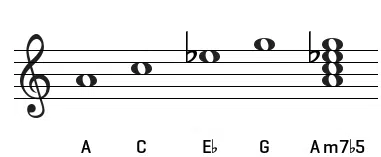
Half-diminished chords are composed of four notes:
- The root note.
- Minor 3rd.
- Diminished 5th.
- Minor 7th.
It is a chord with a min7th above a diminished triad.
A diminished triad is a chord with two minor 3rds stacked on top of each other.
So, instead of having three Major 3rds, it only has one minor 3rd.
The half-diminished chord often serves as either a passing chord or a substitute for minor 7th chords.
Most commonly heard in genres like jazz, blues, and rock, the half-diminished chord sounds very mysterious.
It can be used to craft intriguing harmonic progressions and chord voicings.
As well as add flavor and tension to a chord progression.
This type of chord creates a dissonant yet pleasant sound.
The 5th creates much-desired tension and instability, while the minor 3rd adds sadness and moodiness.
With its dark and mysterious sound, you can use it to elicit various (deep-rooted) feelings.
Needless to say, the half-diminished chord is an invaluable instrument to have in your Producers’ Toolkit.
2. Fully-Diminished Chords
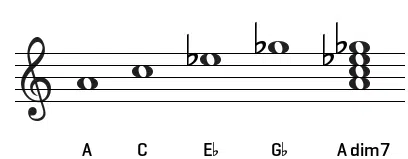
Fully diminished chords also consist of four notes:
- The root
- Minor 3rd
- Diminished 5th
- Diminished 7th
A fully diminished chord is a type of diminished chord that uses all four notes from a diminished seventh chord (above).
Fully diminished chords are composed with two minor thirds above the root, and two diminished fifths above it.
It simultaneously creates both dissonant-sounding notes successfully.
Jazz progressions often use fully diminished chords to convey tension and resolution.
They may also be used to produce an air of mystery and intrigue.
Fully diminished chords are rarely used as tonic chords in a progression.
However, they can be used to create an illusionary tonic.
When used this way, they impart an air of instability which may create tension or suspense.
Fully diminished chords can also serve as passing chords within a progression.
This way, they give the illusion of motion and emphasize harmonic changes within the arrangement.
Fully diminished chords are essential components of jazz and should not be ignored.
They produce a sound that’s unstable yet edgy, and extremely captivating.
It has a very distinctive timbre as well; dark and tense.
This type of sound is best used to build tension toward an eventual climax.
3. Augmented Diminished Chords
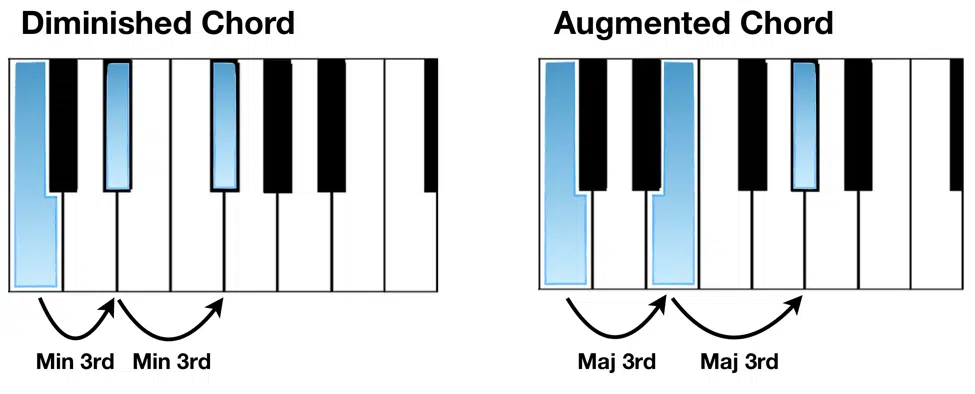
A diminished chord is composed of a root, minor third, and diminished fifth.
Augmented diminished chords, on the other hand, consist of:
- A root
- Augmented 4th
- Diminished 5th
They produce a more dissonant sound when compared to a traditional diminished chord.
The augmented 4th of a chord gives it this distinctive sound.
It’s used to add complexity and fascination.
These chords are frequently used in jazz music to add tension and create dissonance.
Augmented diminished chords can also be used to convey a feeling of resolution.
Adding an augmented 4th to the chord allows for an unexpected conclusion that is sure to impress.
This technique may be used in order to create an intriguing dynamic within a piece of music.
If you’re looking to explore more complex chords and progressions, look no further.
Notation And Symbols For Diminished Chords
Diminished chords have two notations and symbols to help musicians identify them:
Understanding and mastering musical notation and symbols is something you should invest some time into.
Diminished chords play an integral role in many styles of music.
Therefore, it’s essential to be familiar with their notation and symbols.
Here we’ll examine three distinct notations and symbols for diminished chords.
The ‘Dim’ symbol
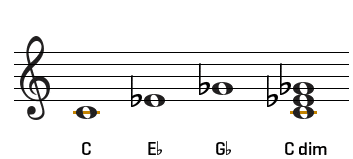
The dim symbol is represented by a circle with a line through it.
It is the first notation used for diminished chords.
This sign can be placed above or below a note to indicate diminished harmony.
For instance: “Cdim” or “Cdeg.”
The Diminished Chord symbol.
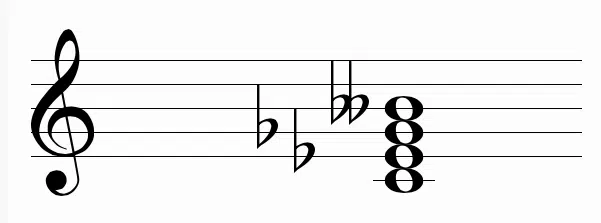
This diminished chord symbol is represented by a triangle with a line through it.
This sign can be placed either above or below a note to indicate that it is diminished.
For instance: “Cdim7” or “Cdeg7”.
The Half-Diminished chord symbol.
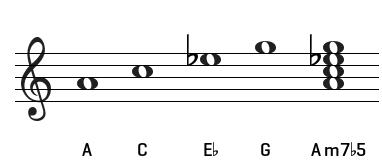
The half diminished chord symbol is represented by a circle with a line through it, and an ‘o’ above that.
This sign can be placed either above or below a note to signify a half-diminished chord.
For instance: “Cm7b5” or “Co”.
Memorizing these three musical symbols will help you quickly identify any diminished chord in any musical genre.
Can you say time-saver?
Roman Numerals and Abbreviations
Roman numerals and abbreviations are essential tools for comprehending and playing diminished chords.
Diminished chords are unique in that they use notes not found elsewhere.
It makes them somewhat difficult to interpret and play.
Using Roman numerals and abbreviations to represent the chords makes playing diminished chords much simpler.
Roman numerals are a system of numerical notation developed in ancient Rome that is widely used to represent chords.
Each Roman numeral corresponds to one note within the chord.
For instance, the Roman numeral “I” would signify the root note, while “II” would indicate the second note (and so on).
Furthermore, these roman numerals can also be used to indicate chord quality.

- Major chords 一 Represented by uppercase Roman numerals.
- Minor chords 一 Represented by lowercase Roman numerals.
Roman numerals and abbreviations can also be used to represent diminished chords.
The two most commonly used abbreviations for diminished chords are ‘deg’ and ‘dim.’
These abbreviations indicate that the chord is a diminished one.
For instance, in C, either Cdeg or Cdim would represent such a chord.
Roman Numerals makes diminished chords much easier.
You don’t need to learn individual notes within the chord to identify and play them.
So, even if you’re a beginner, you’ll be able to get up to speed in no time.
For an in-depth look at roman numerals, plus the 7 best chord progressions for hip-hop music, click here: Best Chord Progressions.
Keyboard Notation
Keyboard notation is an invaluable skill for musicians, particularly those learning how to play chords on a keyboard.
It represents chords and other musical elements with symbols representing keys on a piano or other keyboard instrument.
They make it simpler for players to read, understand, and play chords quickly and accurately.
Diminished chords are composed of three notes that are spaced a minor 3rd apart from one another.
For instance, a C diminished chord would consist of 一 C, E♭, and G♭.

On keyboard notation, they are represented by their associated letters and symbols (C, E♭, and G♭).
All three notes must be played simultaneously for the chord to sound complete.
This may be difficult if you’re a beginner, since these notes may not all be located together on your keyboard.
In keyboard notation, you can group these notes together by adding an ‘overline’ over each letter representing one note.
This line indicates that all three should be played at once.
Understanding and playing chords written in keyboard notation is an invaluable skill for any musician.
Even those with diminished chords, which may seem challenging to play at times.
Make sure to practice and be persistent when first learning.
Before you know it, you’ll be a master at reading and playing chords written in keyboard notation.
Progressions of Diminished Chords
As mentioned earlier, diminished chords are used to add vibrant harmonic color to compositions, as well as create tension and suspense.
A diminished chord is composed of three notes: root, minor third, and flat 5th (known also as the diminished 5th).
There are four distinct progressions for diminished chords to add interest and variety to your piece:
1. The basic diminished chord is the starting point.
It consists of a root, minor third, and flat fifth, and has an unmistakably dissonant sound. It’s great to evoke tension-related emotions and feelings. This chord can be utilized in many different ways, but often serves as the transitional chord between other chords.
2. The second progression is the half-diminished chord.
This chord is identical to the basic diminished chord, but with an added flat seventh. It produces a feeling of anticipation by having a slightly less dissonant sound than its (basic) diminished counterpart. It often leads into a dominant chord.
3. The third progression is the fully diminished seventh chord.
It is composed of a root, minor third, flat fifth, and flat seventh. This chord has an intense dissonant sound. Again, it’s great for tension and/or suspense purposes, and can serve as the transitional point between two other chords.
4. The fourth progression is the augmented 6th chord.
This chord consists of a root, Major 3rd, and augmented 5th/6th notes. It has a particularly unsettling sound but in the best way. Additionally, this chord can serve to transition between two other chords as well.
Diminished chords are an excellent way to add unique harmonic color and texture to a composition.
Diminished 7th Chord Progression
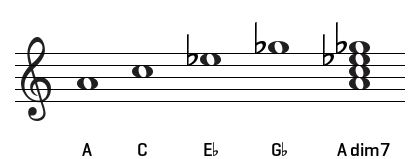
The diminished 7th chord is a mysterious and complex chord often used in jazz and classical music
It’s composed of four distinct notes:
- Root
- Minor 3rd
- Diminished 5th
- Diminished 7th
This particular progression creates an atmosphere of, you guessed it, tension and suspenseful anticipation.
It can function as a transition (from chord to chord), or substitute for the dominant 7th chord.
What’s also cool is its ability to serve as an intro or ending chord within musical compositions.
When you’re thinking of crafting a diminished 7th chord, you have to keep its unique essence in mind.
You should consider ways in which to make the dissonance interesting, as opposed to jarring or overwhelming.
One way to accomplish this is through chromatic movement.
Chromatic movement refers to notes close to the root, but slightly different.
It can be achieved with the use of semitones/tones.
With such a technique, you’ll be able to create a more cohesive and captivating progression.
One way to use the diminished 7th chord is as a substitute for a dominant 7th chord.
In order to do this, simply start with the diminished chord and then ‘resolve’ it back to its dominant counterpart.
This will give you the intriguing and unexpected sound people love to hear.
It’s an incredibly versatile, complex chord that’s capable of producing a variety of sounds, so don’t overlook it.
Diminished Chords In Minor Keys
As you know, diminished chords are an integral component of music theory…
But where they really shine are the minor keys.
A diminished chord contains a diminished fifth 一 an interval that sits one semitone below a perfect fifth.
When played in minor keys, these diminished chords help create tension.
As well as add color and complexity to your pieces.
A diminished chord can be used to move from the root key to its relative major or minor key.
For instance, if a song is in C minor then, by using diminished chords, you could move it to E♭ Major or A minor.
Diminished chords can also be used to add an exciting new layer to a chord progression.
When used this way, the chord adds tension and dissonance; giving the song an exciting, unpredictable vibe.
Diminished Chords In Major Keys
Major keys are one of the most prominent melodic keys in western music.
They are built upon the major scale, and composed of seven notes:
- A root
- Major 3rd
- Perfect 5th
- Major 6th
- Major 7th
- An octave
Diminished chords use similar notes as their major counterparts.
However, they substitute the minor third and diminished fifth for the perfect fifth.
It gives you that alluring, dissonant sound people love.
Diminished chords have many uses in major keys.
They can create a more complex sound, introduce new harmonic elements, and/or add tension.
For instance, you could use one to build anticipation before playing a major chord.
As well as give your listeners some closure after it has been played out.
When using diminished chords in major keys, it’s essential to be mindful of the intense tension they can create.
Avoid overusing them, as they can lead to way too much tension.
Remember to experiment with different combinations of diminished and major chords until you find the ideal balance.
PRO-TIP: Diminished chords can be used to produce modal sounds.
Playing a diminished chord over either minor or major chord progression will produce this extremely unique atmosphere.
Diminished Chords In Different Genres
Diminished chords are most commonly heard throughout pop, rock, jazz, hip-hop, heavy metal, and even country music.
One of the most popular uses found throughout all genres is using diminished chords as a bridge between two other chords.
It works so well for this purpose because it contains a high amount of tension, as you know.
Let’s take a look at the benefits and uses of diminished chords in the following genres:
- Pop
- Jazz
- Classical
Don’t be afraid to experiment with diminished chords during your next songwriting session, regardless of genre.
Diminished Chords In Pop Music
Pop music often uses diminished chords to build tension and drama.
By introducing a dissonant sound, listeners are led on an emotional journey as the song progresses.
You’re led into other chords which provide resolution after all that tension from the diminished chord.
For instance, Cdim7 could lead into a C major chord.
All that anticipation (and resolve) is sure to captivate and fascinate your audience.
Try inserting one diminished chord during the middle of a piece.
It will add another level of interest and complexity.
Especially when combined with other chords to form an effective progression, such as Cdim7 -> Fmaj7 -> B♭.
For the ultimate tension and release in your pop songs, look no further than diminished chords.
Diminished Chords In Jazz
Jazz music often features the use of diminished chords, which are created by decreasing the intervals between notes.
This type of chord creates tension within a piece and gives it an inimitable and captivating soundscape.
Diminished chords are commonly used throughout the jazz world to create a more complex sound.
The drama and surprise factor they impart are unmatched.
Jazz is all about tension and release, so naturally, these chords fit perfectly here.
Furthermore, they create more chromatic sounds which make music appear unpredictable and exciting.
If you want your jazz music to stand out from others, consider using diminished chords.
Diminished Chords In Classical Music
The ♭ (or, ‘flat’) note is an integral element of classical music.
It appears in many genres, but it’s particularly prominent within classical pieces.
It creates interesting melodies and harmonies that classical music is known for.
And wouldn’t you know it, ♭ appears very often as part of diminished chords!
The ♭ typically add tension and drama to songs or pieces while creating interesting harmonies/textures.
Finally, ♭ is also used in modulations – when the music changes from one key to another.
The ♭ serves to bridge the gap between them.
It creates a smooth transition between sections of music that have distinct sounds.
If you create classical music, diminished chords will be your best friend.
Interval Structure Of Diminished Chords
The element that really sets diminished apart from other chord types
It is their interval structure.
Music Theory defines an interval as the distance between two notes; measured in semitones.
When it comes to diminished chords, however, the distance between each note is reduced to a minor 3rd.
Meaning, there’s a three-semitone gap between them all.
This gives the notes in a diminished chord that dissonant, unique sound it’s famous for.
Diminished chords consist of six distinct intervals:
- The first interval 一 The root note.
- The second, third, and fourth intervals 一 Minor 3rds.
- The fifth interval 一 A Major 3rd
- The sixth interval 一 Another minor 3rd.
The cycle of minor thirds can also be heard in other chord types, such as augmented chords (above).
This interval structure forms the basis for all harmonic minor scales and lends them their distinctive sound.
It offers musicians a distinctive interval structure that can add life and depth to their music.
Needless to say, it’s important you get to know them intimately.
Triads

In music theory, a triad is composed of three notes:
- A root.
- A third.
- A fifth.
The most common type is a Major triad, which consists of a root, a major third, and a perfect fifth.
However, there are many variations on this theme.
One particular variation that stands out is the Diminished Triad which consists of a root, minor third, and diminished fifth.
This chord type often creates tension or suspense within a piece by creating subtle shifts in dynamics.
The diminished triad 一 also known as a diminished chord 一 is typically written as a slash chord with the root at the bottom, and the other two notes on top.
For instance, a C diminished chord would be written as C/Eb/Gb.
This type of chord is frequently used in jazz to produce dissonant and suspenseful sounds.
It can serve as a passing chord or create tension within an arrangement.
Furthermore, it often precedes modulations or key changes within pieces.
The diminished triad is an effective tool for creating various sounds in music.
It adds an extremely desirable texture and emotion.
Tetrads
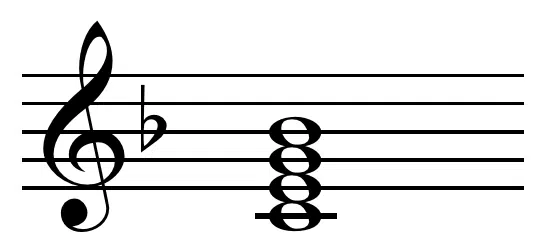
Tetrads are a type of diminished chord composed of two minor thirds stacked atop each other.
In a tetrad, the Root Note is at the lowest note.
While its three neighboring notes are: minor thirds, Major thirds, and perfect fourths (above it).
Tetrads produce a more dissonant sound than other chords.
It’s the reason why they’re commonly used as passing chords.
They’re commonly used in jazz and contemporary music as passing chords.
When used in progressions, it can create an atmosphere of tension and release as it resolves into a more secure chord.
Tetrads can also be used to create captivating harmonic motion by altering the voicing of the chord.
For instance, by shifting up the order of notes within a chord, you can achieve more melodic movement within your progression.
Furthermore, you could substitute tetrads for major or minor chords.
This adds even more dissonance and tension within your arrangement.
Tetrads are an intriguing and versatile chord type that can add a special touch to any musical piece.
It also adds harmonic motion and creates unique voicings.
If you’re looking to experiment with something new in your compositions, try experimenting with tetrads.
You never know the masterpieces you can unleash.
Enharmonic Equivalents Of Diminished Chords
In music, chords can be expressed as diminished harmonies to help describe their pitch.
There are 7 distinct enharmonic equivalents to diminished chords.
An enharmonic equivalent is a chord or note with the same pitch, just with different spellings/names.
Thus, there are 7 ways to spell diminished chord.
Let’s take a look at each of these chords (individually) to see how they’re used in compositions:
A minor 7th flat five chord (root note, minor 3rd, flat five, minor 7th)
This particular chord has slightly brighter tones than its diminished counterpart, but still maintains tension within it.
A Major 6th flat five chord (root note, Major 3rd, flat five, Major 6th)
This chord can create an atmospheric vibe and has its own distinctive sound.
A minor 6th flat five chord (root note, minor 3rd, flat five, minor 6th)
This chord has more of an upbeat sound than its diminished counterpart. You’ll want to incorporate it when contentment or peace is the goal.
A Major 7th flat five chord (root note, Major 3rd, flat five, Major 7th)
With its lush sound, this chord can add some serious sophistication to compositions.
A minor 9th flat five chord (root note, minor 3rd, flat five, minor 9th)
This diminished chord has a unique sound that can be used to create atmosphere and tension.
A Major 9th flat five chord (root note, Major 3rd, flat five, Major 9th)
With its bright, upbeat sound it can be used to elicit feelings of joy. Your listeners will instantly be drawn in and fall in love with this chord.
A minor 11th flat five chord (root note, minor 3rd, flat five, minor 11th)
With its dissonant sound, this chord can be used to induce feelings of unease in others. As you know, that particular feeling can really make your listeners connect with the sound.
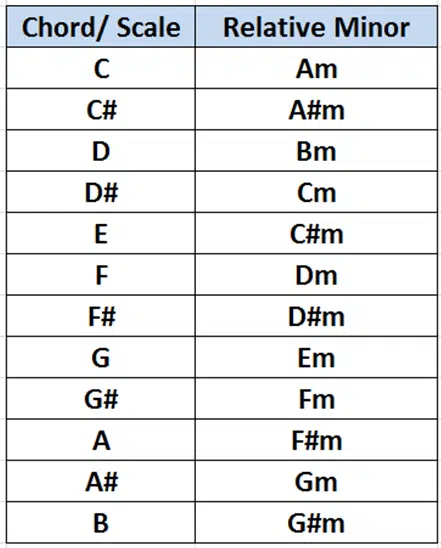
Relative minors permit you to use the same chords & melodies in 2 distinct keys.
It opens up exciting harmonic possibilities and gives your songs extra depth.
- Major keys often lead to lighter music in minor keys. They create a darker, more melancholic atmosphere.
- Minor chords have an introspective quality compared to major ones. They tend to be featured in sad/tragic songs and are perfect choices for emotional ballads.
The relative minor key can be used to create contrast and tension.
By shifting from a major key to its relative minor, you can add intensity to the piece and craft an even more dramatic arc.
It allows you to explore various harmonic possibilities and create epic pieces.
So the next time you’re writing a song, consider switching it up to relative minor for an even more captivating sound.
Each chord has a distinctive sound and can be used to evoke different moods and atmospheres within a composition.
Experiment around with each different variation for optimum results.
A dominant seventh chord (a major triad & minor 7th note)
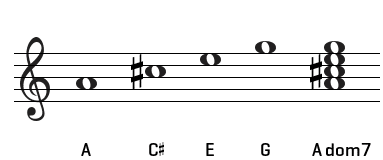
Commonly referred to as just ‘the seventh chord,’ its seven notes make it one of music’s most important chords.
Their smooth, mellow tone often elicits suspense or tension.
The minor seventh gives this chord its unique character and sets it apart from other chords.
A dominant seventh chord can be rearranged to create the notes of a diminished chord.
Therefore, it could even serve as a substitute for one.
This substitution can create exciting and unexpected chord progressions.
9 Timeless Examples Of Diminished Chords
Diminished chords can be used in many different musical genres, styles, and contexts.
Let’s take a look at 8 timeless examples of diminished chords in popular music:
- “Let It Be” by The Beatles – This timeless tune features a diminished chord in the chorus. It creates an atmospheric sense of tension which is ultimately resolved at the end.
- “Bohemian Rhapsody” by Queen – This song’s slow and dramatic introduction features a diminished chord.
- “All I Want for Christmas” by Mariah Carey – Mariah Carey loves using diminished chords in her music. She loves creating tension for her listeners.
- “Every Time You Go Away” by Paul Young – This timeless, emotional hit uses diminished chords to invoke that particular emotion that people love to experience.
- “This Love” by Maroon 5 – This Maroon 5 hit uses diminished chords throughout this song to really capture the attention of their audience. Let’s just say, it worked.
- “Stairway to Heaven” by Led Zeppelin – This timeless rock song opens with a diminished chord, setting the stage for what follows throughout the rest of the piece.
- “My Girl” by The Temptations – This timeless soul tune features a diminished chord in the bridge that adds texture and complexity to the song.
- “No Woman, No Cry” by Bob Marley – This reggae classic features a diminished chord in the chorus that adds an air of urgency to the song.
- “Purple Rain” by Prince – This brilliant song features a diminished chord in the bridge, creating tension that is ultimately resolved at the end of the song.
Diminished Chords: Advanced Concepts
Mastering the art of diminished chords is no easy task…
However, with the right techniques to apply and concepts to remember, you’ll be one in no time.
The following chords, arpeggio, and scale can help you accelerate your diminished chord game in no time.
- Diminished Scale – The diminished scale can help you create memorable and captivating diminished chord progressions. The diminished scale is symmetrical and consists of alternating tones & semitones. It gives you the opportunity to create unique progressions otherwise not possible with alternative scales.
- Split Diminished Chords – Split diminished chords are made up of two diminished chords that have been split in half by an interval. They provide subtle complexity to chord progressions. They can also be used to create intriguing and unexpected harmonic progressions as well.
- Diminished Arpeggios – Diminished arpeggios add a unique flavor to chord progressions. With them, you can create an “outside” sound that adds another level of complexity to your playing.
- Augmented Chords – Augmented chords create a captivating sound not found with other chord types. Combining augmented chords with diminished chords creates beautiful progressions.
- Suspended Chords – Suspended chords are composed of two fourths. They create a fascinating sound and add another level of complexity to a chord progression. Combining suspended chords with diminished chords creates a super engaging tone.
- Diminished 7ths – Diminished 7ths are chords composed of two minor thirds and a major third. They produce a rare sound not found with other chord types. By combining diminished 7ths with other chords, you can create magical progressions.
- Diminished 9ths – Diminished 9ths are chords composed of two minor thirds and two major thirds. Like the others in this list, they create an intriguing sound and can incorporate a level of depth otherwise unachievable. The progressions they produce when combined with other chords are truly stunning.
- Diminished 11ths – Diminished 11ths are chords composed of two minor thirds and three major thirds. Their unique sound is perfect for captivating your audience and entrancing your listeners. Combine diminished 11ths with other chords for grandiose progressions.
- Diminished 13ths – Diminished 13ths are chords made up of two minor thirds and four major thirds. It creates an intriguing sound and adds complexity to chord progressions. Mix them with other chords and watch the magic unfold.
- Modal Interchange 一 A musical technique that enables musicians to harmonize chords in different keys or modes. In this technique, one chord is replaced with another that’s of the same key or mode. For instance, replacing a diminished chord with a major one.
- Double Diminished Chords 一 Double diminished chords are composed of two diminished chords stacked atop each other.
Double diminished chords can be created in 2 ways:
- Join together two diminished chords with the same root note.
- Join together two diminished chords with different root notes.
Both methods offer a range of sounds/textures, create tension, and add color and vibrancy to the chord progression.
The sound produced by a double diminished chord will depend on its context.
They’re often used to evoke a feeling of mystery and suspense.
Plus, they add a certain level of inspiration and/or anticipation.
You can surely benefit from using double diminished chords when creating interesting and unique melodic ideas.
FINAL THOUGHTS
Diminished chords are an integral part of music theory.
Comprehending their complexities can offer a world of new opportunities for your music.
By integrating them, you’ll be able create captivating and unique sounds.
Your listeners will appreciate the immense tension, suspense, and emotion diminished chords impart.
Use the aforementioned techniques, tips, and tricks to breathe new life to your chord progressions.
You’ll want to start with the most entrancing, professional, intriguing chord progressions around.
You can find them within the FREE Unison Famous MIDI Chord Progressions pack.
It contains epic chord progressions from the biggest hit songs of all time.
Needless to say, with or without added diminished chords this pack is absolutely astonishing.
Until next time…







 40 Chord
Progressions
40 Chord
Progressions

Leave a Reply
You must belogged in to post a comment.